coil CHEVROLET CAMARO 1967 1.G Chassis Workshop Manual
[x] Cancel search | Manufacturer: CHEVROLET, Model Year: 1967, Model line: CAMARO, Model: CHEVROLET CAMARO 1967 1.GPages: 659, PDF Size: 114.24 MB
Page 10 of 659
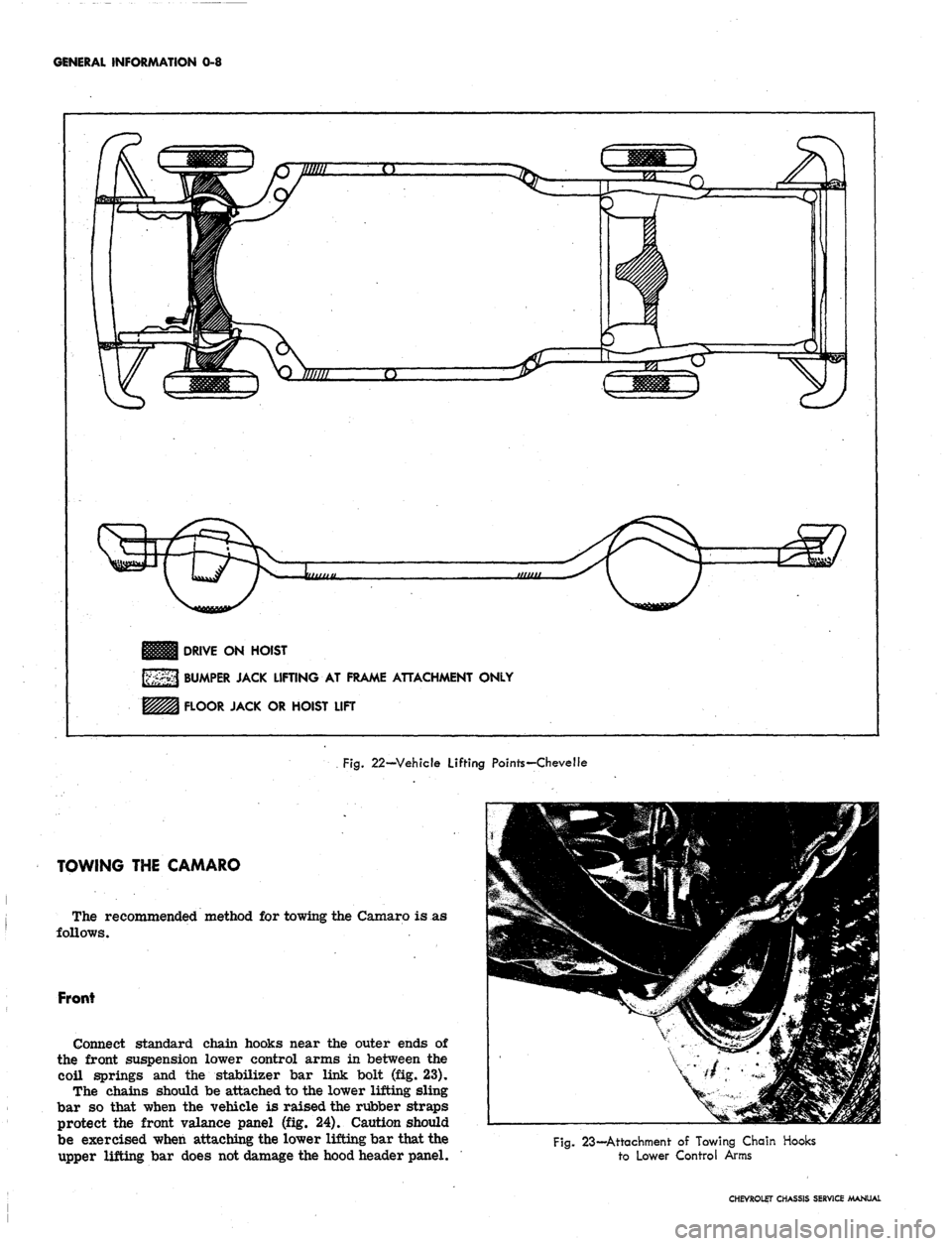
GENERAL INFORMATION 0-8
nun
Illllfl Q
i,,,,,,,,
DRIVE ON HOIST
BUMPER JACK LIFTING AT FRAME ATTACHMENT ONLY
FLOOR JACK OR HOIST LIFT
Fig.
22—Vehicle Lifting Points—Chevelle
TOWING THE CAMARO
The recommended method for towing the Camaro is
follows.
Front
Connect standard chain hooks near the outer ends of
the front suspension lower control arms in between the
coil springs and the stabilizer bar link bolt (fig. 23).
The chains should be attached to the lower lifting sling
bar so that when the vehicle is raised the rubber straps
protect the front valance panel (fig. 24). Caution should
be exercised when attaching the lower lifting bar that the
upper lifting bar does not damage the hood header panel.
Fig. 23—Attachment of Towing Chain Hooks
to Lower Control Arms
CHEVROLET CHASSIS SERVICE MANUAL
Page 60 of 659
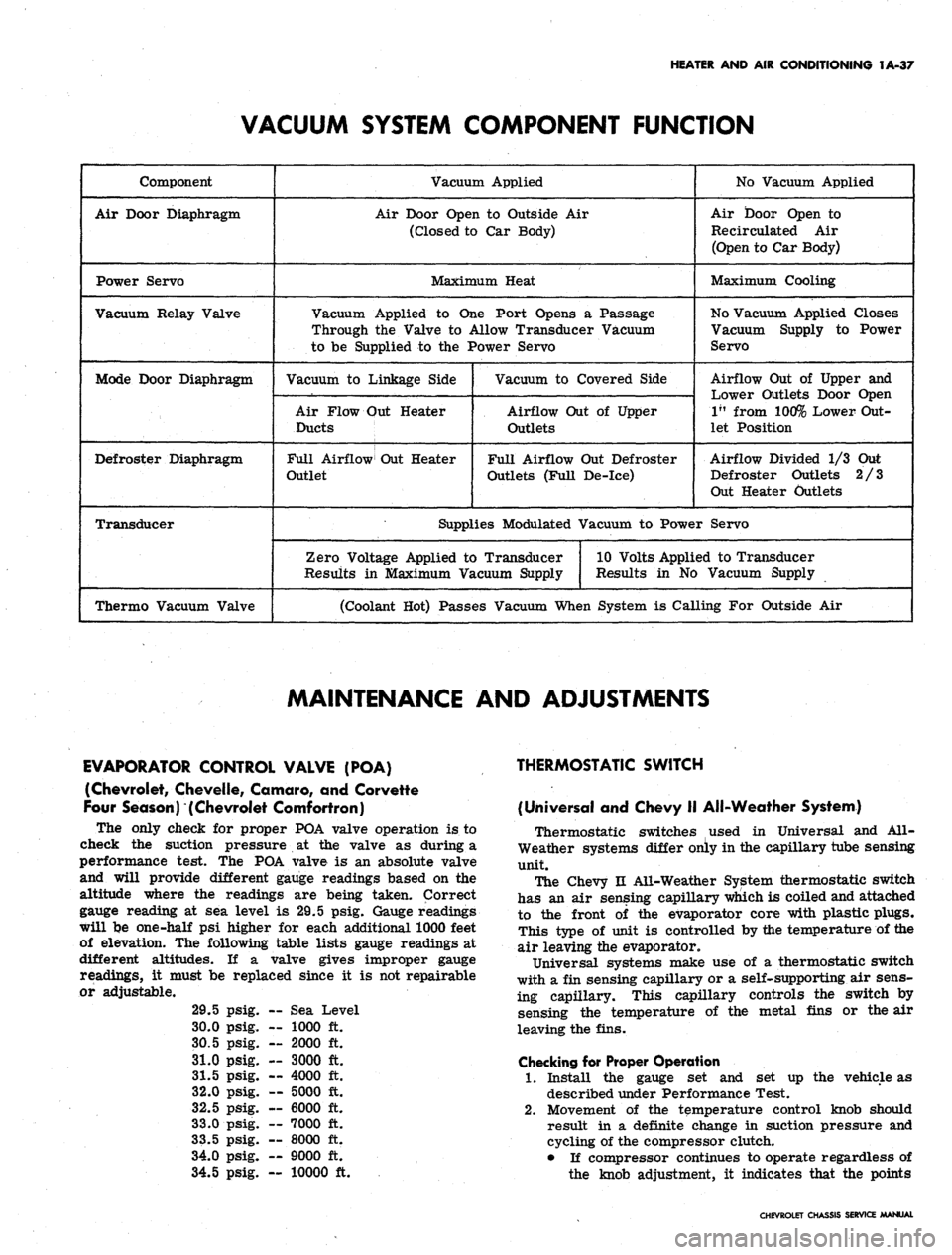
HEATER AND AIR CONDITIONING 1A-37
VACUUM SYSTEM COMPONENT FUNCTION
Component
Air Door Diaphragm
Power Servo
Vacuum Relay Valve
Mode Door Diaphragm
Defroster Diaphragm
Transducer
Thermo Vacuum Valve
Vacuum Applied
Air Door Open to Outside Air
(Closed to Car Body)
Maximum Heat
Vacuum Applied to One Port Opens a Passage
Through the Valve to Allow Transducer Vacuum
to be Supplied to the Power Servo
Vacuum to Linkage Side
Air Flow Out Heater
Ducts
Full Airflow Out Heater
Outlet
Vacuum to Covered Side
Airflow Out of Upper
Outlets
Full Airflow Out Defroster
Outlets (Full De-ice)
No Vacuum Applied
Air Door Open to
Re circulated Air
(Open to Car Body)
Maximum Cooling
No Vacuum Applied Closes
Vacuum Supply to Power
Servo
Airflow Out of Upper and
Lower Outlets Door Open
1"
from 100% Lower Out-
let Position
Airflow Divided 1/3 Out
Defroster Outlets 2/3
Out Heater Outlets
Supplies Modulated Vacuum to Power Servo
Zero Voltage Applied to Transducer
Results in Maximum Vacuum Supply
10 Volts Applied to Transducer
Results in No Vacuum Supply
(Coolant Hot) Passes Vacuum When System is Calling For Outside Air
MAINTENANCE AND ADJUSTMENTS
EVAPORATOR CONTROL VALVE (POA)
(Chevrolet, Chevelle, Comoro, and Corvette
Four Season) (Chevrolet Comfortron)
The only check for proper POA valve operation is to
check the suction pressure at the valve as during a
performance test. The POA valve is an absolute valve
and will provide different gauge readings based on the
altitude where the readings are being taken. Correct
gauge reading at sea level is 29.5 psig. Gauge readings
will be one-half psi higher for each additional 1000 feet
of elevation. The following table lists gauge readings at
different altitudes. If a valve gives improper gauge
readings, it must be replaced since it is not repairable
or adjustable.
29.5
30.0
30.5
31.0
31.5
32.0
32.5
33.0
33.5
34.0
34.5
psig.
psig.
psig.
psig.
psig.
psig.
psig.
psig.
psig.
psig.
psig.
— Sea 1
— 1000
— 2000
— 3000
— 4000
— 5000
— 6000
— 7000
— 8000
— 9000
Level
ft.
ft.
ft.
ft.
ft.
ft.
ft.
ft.
ft.
— 10000 ft.
THERMOSTATIC SWITCH
(Universal and Chevy II All-Weather System)
Thermostatic switches used in Universal and All-
Weather systems differ only in the capillary tube sensing
unit.
The Chevy n All-Weather System thermostatic switch
has an air sensing capillary which is coiled and attached
to the front of the evaporator core with plastic plugs.
This type of unit is controlled by the temperature of the
air leaving the evaporator.
Universal systems make use of a thermostatic switch
with a fin sensing capillary or a self-supporting air sens-
ing capillary. This capillary controls the switch by
sensing the temperature of the metal fins or the air
leaving the fins.
Checking for Proper Operation
1.
Install the gauge set and set up the vehicle as
described under Performance Test.
2.
Movement of the temperature control knob should
result in a definite change in suction pressure and
cycling of the compressor clutch.
• If compressor continues to operate regardless of
the knob adjustment, it indicates that the points
CHEVROLET CHASSIS SERVICE MANUAL
Page 99 of 659
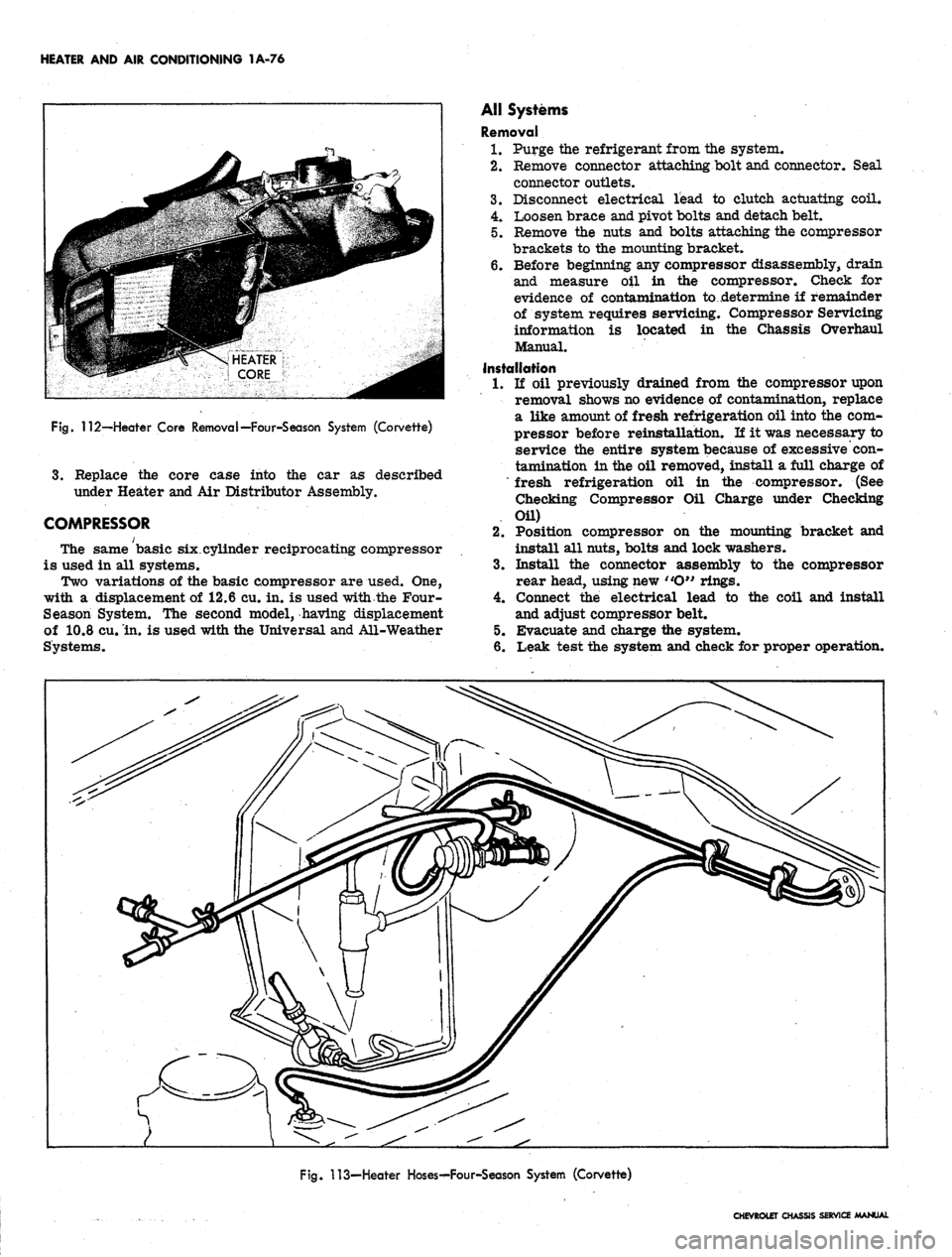
HEATER AND AIR CONDITIONING 1A-76
Fig.
112—-Heater Core Removal—Four-Season System (Corvette)
3.
Replace the core case into the car as described
under Heater and Air Distributor Assembly.
COMPRESSOR
The same basic six.cylinder reciprocating compressor
is used in all systems.
Two variations of the basic compressor are used. One,
with a displacement of 12.6 cu. in. is used with the Four-
Season System. The second model, having displacement
of 10.8 cu. in. is used with the Universal and All-Weather
Systems.
AH Systems
Removal
1.
Purge the refrigerant from the system.
2.
Remove connector attaching bolt and connector. Seal
connector outlets.
3.
Disconnect electrical lead to clutch actuating coil.
4.
Loosen brace and pivot bolts and detach belt.
5. Remove the nuts and bolts attaching the compressor
brackets to the mounting bracket.
6. Before beginning any compressor disassembly, drain
and measure oil in the compressor. Check for
evidence of contamination to ..determine if remainder
of system requires servicing. Compressor Servicing
information is located in the Chassis Overhaul
Manual.
Installation
1.
li oil previously drained from the compressor upon
removal shows no evidence of contamination, replace
a like amount of fresh refrigeration oil into the com-
pressor before reinstallatLon. If it was necessary to
service the entire system because of excessive con-
tamination in the oil removed, install a full charge of
"fresh refrigeration oil in the compressor. (See
Checking Compressor Oil Charge under Checking
Oil)
2.
Position compressor on the mounting bracket and
install all nuts, bolts and lock washers.
3.
Install the connector assembly to the compressor
rear head, using new "O" rings.
4.
Connect the electrical lead to the coil and install
and adjust compressor belt.
5. Evacuate and charge the system.
6. Leak test the system and check for proper operation.
Fig.
113—Heater Hoses^-Four-Season System (Corvette)
CHEVROLET CHASSIS SERVICE MANUAL
Page 101 of 659

HEATER AND AIR CONDITIONING 1A-78
WIRING DIAGRAMS
Blower
Motor
Resistor
•
Asm
EVAPORATOR—v
ASM.
\
-Diode
(Arc I
suppressor)
^\
16B
—>
-COMPRESSOR
Clutch Coil
•To battery positive
(+) terminal
No vacuum
in hose
#3
Blower
intake
air
Outside
air entry
Valve
by vacuum
in
hose
#3
Valve
normally
closed (spring
held)
Inside
car
air
(Recirc.)
AIR INLET
VALVE
POSITION:
Outside
air
intake
Recirc. air'intake
CONTROL ASM
TEMP CONTROL LEVER
(Operates temp valve
cable
&
equipment
in
chart shown below)
Compressor
Sw.
(Normally closed
Temp valve
begins
to
open
valveV
cable
arm
•Fan Speed Selector Switch
Switch
lever
position
Off
Low
Med
High
Contacts
made
B
to
None
BtoL
B to L
&
M
B to
L
& H
Fan
speed
Low
Low
Med
High
Resistance
in series with
Bio Motor
Hi
Rl
(RiR2)/(Rl+R2)
None
•Blower switch contacts must
be
dosed
before
fan
switch will
be
operable.
COLD
(O.
A.)
COLD a.A.)
Blower
H
y—low
switch
M/
-med
(Norm,
closed
contacts)
Fan speed switch
(See chart
at
left)
To vacuum,
tank
EXTENSION—vy
Horn relay "Bat" WIRE
ASM
X
harness
terminal
V
.**-__.. ;_
1 I panel
Legend:
___. —
Production wiring
Wire
is
part
of
equip.
•—————* Air
conditioning
wrg.
| i
T Agn. sw.
accsy
I term.
I
Temp
Control
Lever
Position
OFF
VENT.
COLD(I.A.)
COLEKO.AJ
HOT
Blower
(Master)
switch
contacts
Open
Closed
Closed
Closed
Closed
Vac switch
connects
vac source
to hose
#
#2
#2
&
#3
None
#3
#2
&
#3
Compressor
switch
contacts:
Open
Open
Closed
Closed
Open
Blower
intake
air
Outside
car air
intake used
Inside
car air
recirculated
Outside
car air
intake used
.Outside
car air
intake used
Fig. 114—Chevrolet—Four-Season Wiring Diagram
CHEVROLET CHASSIS SERVICE MANUAL
Page 102 of 659
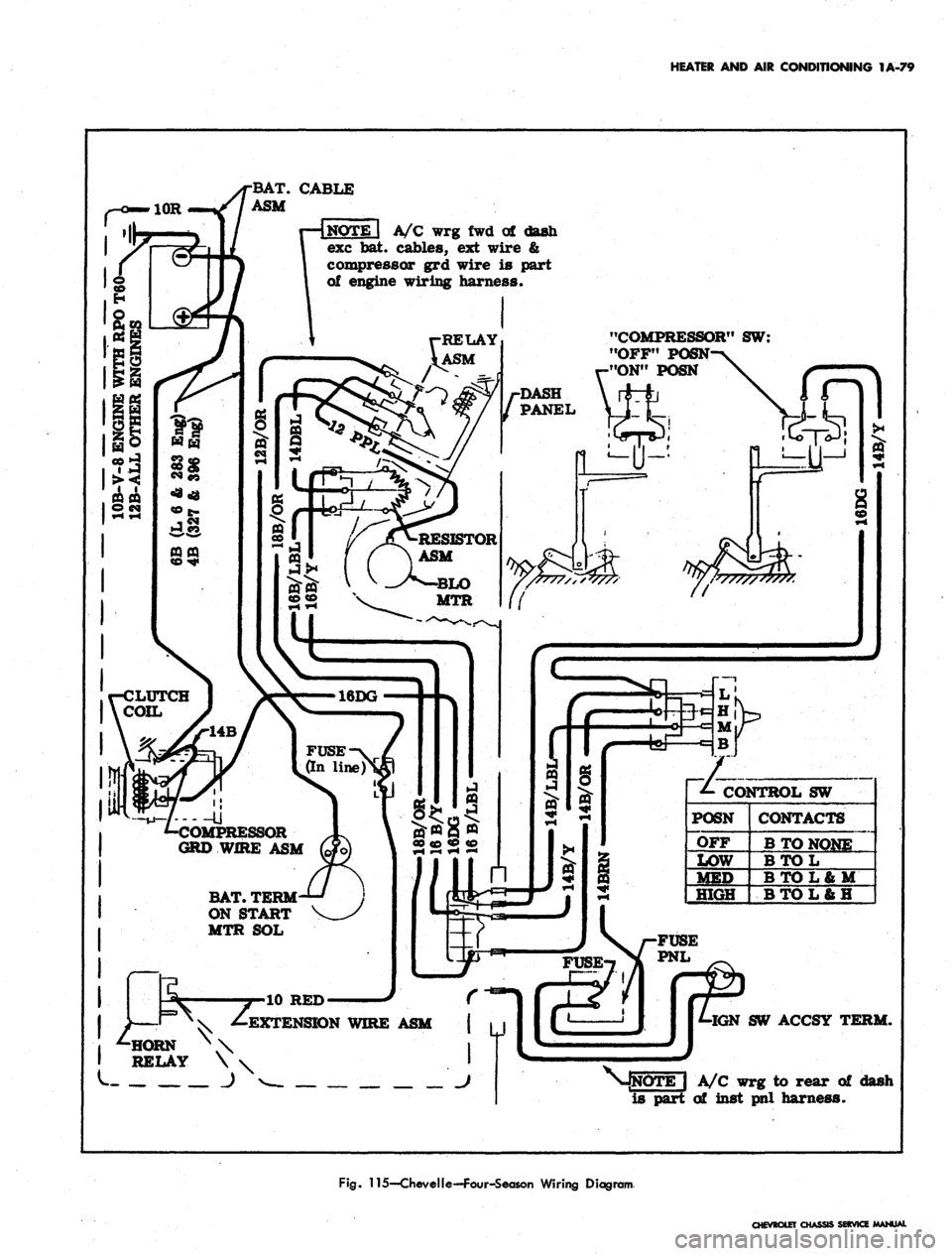
HEATER
AND AIR CONDITIONING IA-79
BAT.
CABLE
ASM
A/C
wrg fwd of
dash
exc
bat.
cables,
ext
wire
&
compressor
grd
wire
is
part
of engine wiring harness.
"COMPRESSOR"
SW:
"OFF" POSN
"ON"
POSN
RELAY
ASM
/-DASH
/
PANEL
RESISTOR
ASM
LUTCH
COIL
:OMI
GRD
WIRE
ASM
MPRESSOR
BAT.
TERM
ON START
MTR SOL
EXTENSION WIRE ASM
._
J
J
^-CONTROL
SW
CONTACTS
B TO NONE
BTOL
BTOL&M
BTOL6H
•IGN SW ACCSY TERM.
A/C wrg
to
rear
of
dash
of
inst pnl harness.
Fig.
115—CheveIle—Four-Season Wiring Diagram
CHEVROLET
CHASSIS SERVICE MANUAL
Page 103 of 659

HEATER
AND AIR
CONDITIONING
1A-80
EVAPORATOR ASM.
Blower
Motor
INSIDE VALVE
(Normally closed
-spring held)
PLENUM VALVE
(Normally open
-spring held)
Actuator
(Vacuum
operated)
Inside car air (Recirc*
CONTROL ASM
TEMP CONTROL LEVER
•(Operates temp valve
cable
&
equipment in
hart shown below)
Temp valve
begins to
16DG
Fuse (In-line^
COMPRESSOR
Clutch Coil DASH-
PANEL
•Fan Speed Selector Switch
Switch
lever
position
Off
Low
"HeST
High
Contacts
B to
None
BtoL
B to L b U
BtoL&H
Fan
speed
Low
Low
Med
High
Resistance
in series with
Bio Motor
Rl
Rl
RlR2)/(Rl+R2)
None
•Blower switch contacts must be closed
before fan switch will be operable.
-To battery positive
(-0 terminal
•
Horn relay
terminal"
"Batf
To vacuum
tank
EXTENSION
WIRE
ASM
(Normally closed
contacts-*vac
operated)
7
*- Fan speed switch
(See chart at left)
•/-Wire is
\ part of
I inst panel
harness
Legend:
— Production wiring
————
Wire Is part of equip.
•mmmmmmmmmmmmmm*
AIT
Conditioning
WTg*
Temp
Control
Lever
Position
OFF
VENT
COLD
a.A.)
COLD
(O.A.)
HOT
Blower
(Master)
switch
contacts
Open
Closed
Closed
Closed
Closed
Vac switch
connects
vac source
to hose #
#2
&
#3
#2
#3
None
#2
Compressor
switch
contacts^
Open
Open
Closed
Closed
Open
Blower
intake air
Outside car air
intake used
Inside car air
recir culated
Outside car air
intake used
Outside car air
intake used
Fig.
116—Camaro—Four-Season Wiring Diagram
CHEVROLET CHASSIS SERVICE
Page 105 of 659
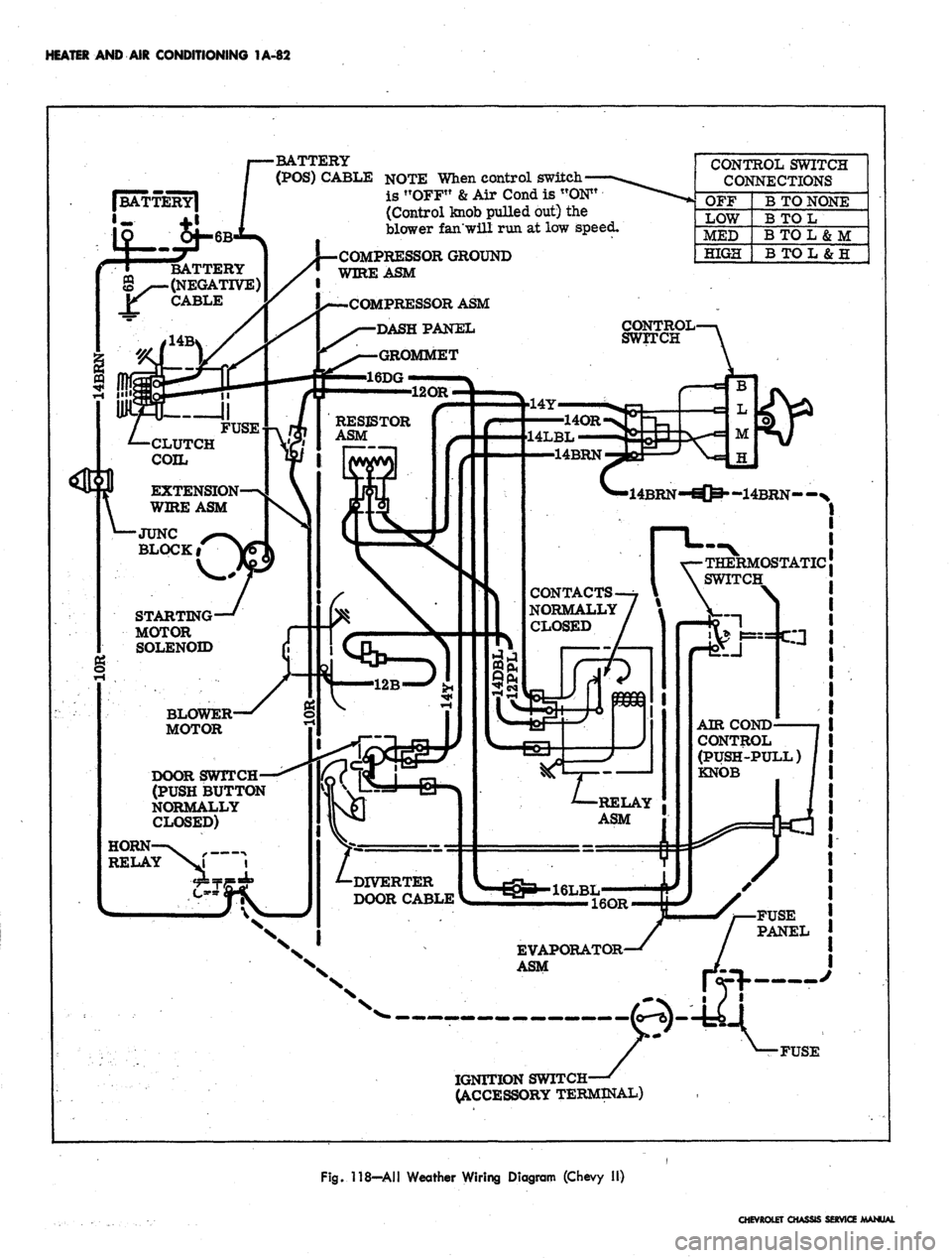
HEATER AND AIR CONDITIONING 1A-82
•BATTERY
(POS)
CABLE
NOTE
When
control
switch*
is !TOFF"
&
Air
Cond
is
"ON"
(Control
knob
pulled
but) the
blower
fan'will
run at low
speed.
CONTROL
SWITCH
CONNECTIONS
OFF
LOW
MED
HIGH
B
TO
NONE
B
TO L
BTOL&M
B
TO L
&
H
COMPRESSOR
GROUND
WIRE
ASM
BATTERY
(NEGATIVE)
CABLE
COMPRESSOR
ASM
DASHPAJSTEL
GROMMET
16DG
CONTROL
SWITCH
RESISTOR
ASM
14LBL
14BRN
CLUTCH
COIL
EXTENSION
WIRE
ASM
-14BRN--N
JUNC
BLOCKi
OSTATIC
SWITCH
CONTACTS
NORMALLY
CLOSED
STARTING
MOTOR
SOLENOID
BLOWER
MOTOR
AIR
COND
CONTROL
(PUSH-PULL)
KNOB
DOOR
SWITCH
(PUSH
BUTTON
NORMALLY
CLOSED)
RELAY
ASM
HORN
RELAY
DIVERTER
DOOR CABLE
FUSE
PANEL
EVAPORATOR
ASM
IGNITION SWITCH-
ACCESSORY TERMINAL)
Fig. 118—All Weather Wiring Diagram (Chevy II)
CHEVROLET CHASSIS SERVICE MANUAL
Page 126 of 659

CORVETTE BODY 1B-T9
Fig.
43—Removing Regulator Assembly
REAR QUARTER
DOOR SILL PLATE AND MOLDING
Figure 49 shows assembly details of both the door sill
plate and molding. The sill plate which retains the car-*
pet, the cowl trim windlace and lock pillar front edge
trim are retained to the body by six screws.
The molding assembly, which replaces a rocker panel,
is quickly and easily replaced by removing 10 retaining
screws. The sill molding retainer is also fastened to the
body with screws.
REAR END
FOLDING TOP COMPARTMENT LID
Adjustments
Hinges
The folding top compartment lid should be adjusted so
that in the closed position the surface of the lid is flush
with surrounding body surfaces and space between lid
edge and body is 1/16" to 3/16" at sides and 3/16" to
1/4" at rear. Whenever lid position is changed on hinges,
lock engagement must be inspected and adjusted if neces-
sary. Adjust hinge position as follows:
1.
Scribe a line on lid surface following contour of hinge
strap.
This will ease observation of lid movement
during adjustment (fig. 51).
2.
To raise or lower top surface of lid, add or remove
hinge shims.
3.
To adjust spacing between lid edges and body, loosen
hinge-to-lid screws and shift lid as required.
Lock
Lock engagement may be adjusted as follows:
1.
Striker plates may be shimmed to adjust the depth
of lock engagement in striker plate. When this ad-
justment is made, release of lock should be tested
and adjusted as required.
2.
Release of lock may be adjusted by loosening lock
assembly retaining bolts and moving lock in ap-
propriate direction to the limit of slotted holes in
, lock base. Further adjustment may be gained by
moving cable retainer in appropriate direction.
Hinges
(Refer to Figure 52)
Removal
1.
Scribe around hinge as shown in Figure 51.
2.
Hinge may be removed as an assembly by opening
top compartment lid fully and removing 3 retaining
screws. Note number of shims found between hinge
frame and compartment floor.
3.
To remove spring from hinge assembly, close top
compartment lid as far as possible and insert Tool
J-9559 between expanded coils in spring. Opening
top compartment lid fully will allow removal of
spring as shown in Figure 53.
4.
As soon as spring is removed, insert long bolt sup-
plied with J-9559 through holes in end of tool, pass-
ing it through spring, and install nut on bolt.
Spring may be removed from J-9559 or J-9559 may be
installed in a new spring, by the following method:
1.
Place a closed 6 or 8 inch "C" clamp in a vise or
fasten it to a heavy bench top (bench should be fas-
tened to floor).
2.
Hook one end of spring in clamp and the other end
in hook of chain hoist, "cherrypicker" or equivalent,
as shown in Figure 54.
3.
Stretch the spring enough to allow insertion of
J-9559. Install through bolt if spring is not to be in-
stalled on hinge at once.
installation
1.
Install same number of shims as removed or, if
repairing collision damage, etc., position hinge in
compartment, install upper mounting screws, fill
gap between floor and hinge frame with shims and
install lower mounting screw.
2.
If spring has been removed from hinge, install
spring in J-9559 and place spring on hinge with com-
partment lid raised; closing lid releases J-9559 for
removal. Upper end of spring should rest in one of
three notches yielding best lid operation. About 3
pounds pressure should be necessary to close lid.
Lock
Removal
1.
Remove cable mounting clamps. Remove retainer
from control cable assembly and disengage cable
from control.
2.
Scribe a mark on lid following outer contour of lock
assembly.
3.
Remove 3 lock assembly retaining screws and re-
move lock from compartment lid.
Installation
1.
Place lock assembly on compartment lid within
scribed line and install retaining screws.
2.
Install end of cable in control assembly and fasten
retainer securely.
3.
Test operation of lock thoroughly, adjusting if neces-
sary as outlined in this section.
Control
Removal
1.
Remove inner mounting clamps from both cables
and disengage cables from control by removing
retainers.
CHEVROLET CHASSIS SERVICE MANUAL
Page 165 of 659
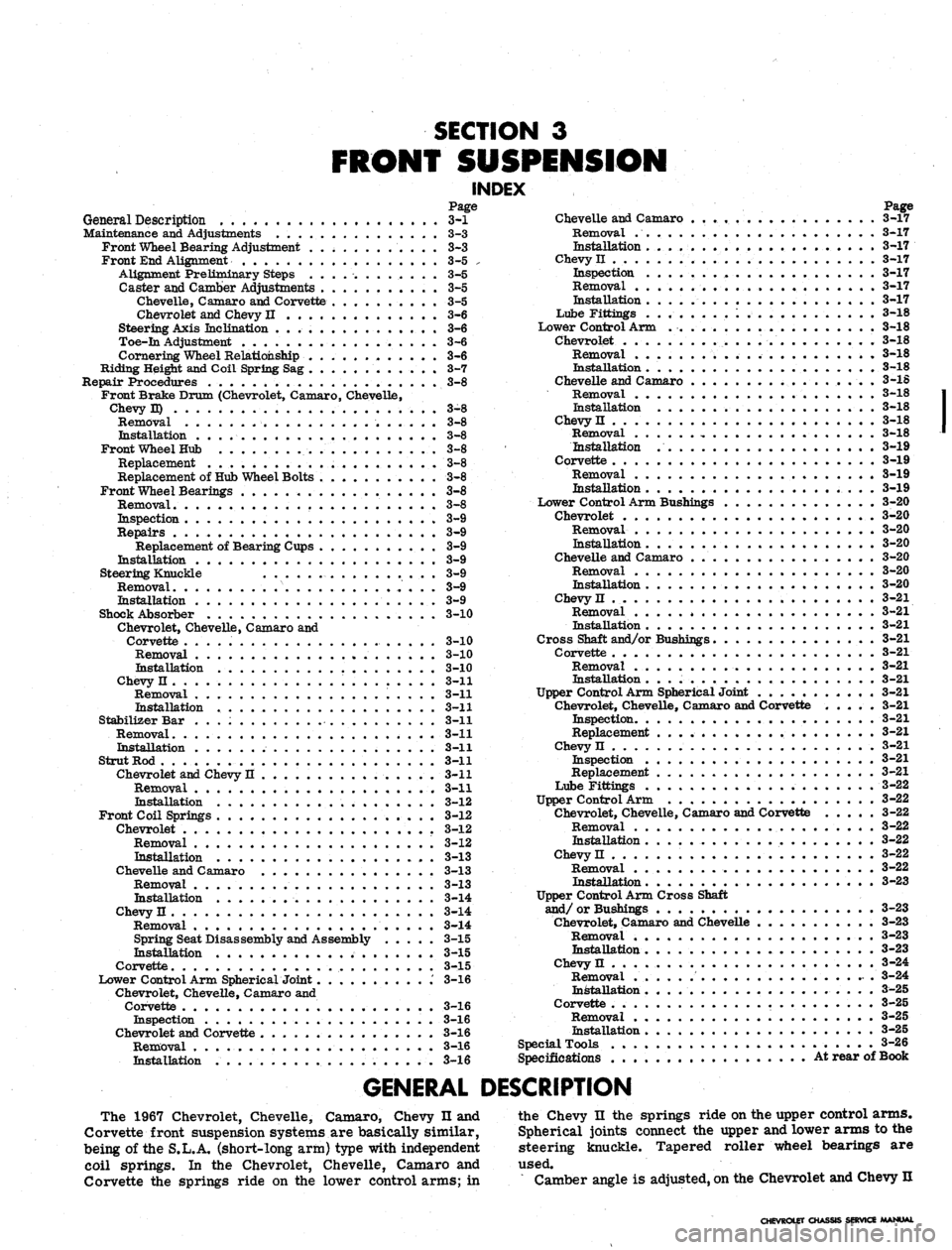
SECTION
3
FRONT SUSPENSION
INDEX
Page
General Description
. . . . 3-1
Maintenance and Adjustments
3-3
Front Wheel Bearing Adjustment
3-3
Front End Alignment
3-5 .
Alignment Preliminary Steps ............
3-5
Caster
and
Camber Adjustments
. . 3-5
Chevelle, Caxnaro
and
Corvette
3-5
Chevrolet and Chevy
II 3-6
Steering Axis Inclination
3-6
Toe-in Adjustment
3-6
Cornering Wheel Relationship
3-6
Riding Heigit
and
Coil Spring Sag
3-7
Repair Procedures
3-8
Front Brake Drum (Chevrolet, Camaro, Chevelle,
Chevy E)
. . 3-8
Removal
3-8
Installation
3-8
Front Wheel Hub
3-8
Replacement
. . . . . 3-8
Replacement
of
Hub Wheel Bolts
3-8
Front Wheel Bearings
. . 3-8
Removal
3-8
Inspection
3-9
Repairs
. . 3-9
Replacement
of
Bearing Cups
3-9
Installation
3-9
Steering Knuckle
. . . 3-9
Removal
3-9
Installation
3-9
Shock Absorber
3-10
Chevrolet, Chevelle, Camaro
and
Corvette
3-10
Removal
, . 3-10
Installation
3-10
Chevy
It 3-11
Removal
3-11
Installation
3-11
Stabilizer
Bar 3-11
Removal
3-11
Installation
3-11
Strut Rod
3-11
Chevrolet and Chevy
II 3-11
Removal
3-11
Installation
3-12
Front Coil Springs
3-12
Chevrolet
3-12
Removal
3-12
Installation
3-13
Chevelle
and
Camaro
3-13
Removal
3-13
Installation
3-14
Chevy H
3-14
Removal
3-14
Spring Seat Disassembly and Assembly
3-15
Installation
3-15
Corvette
3-15
Lower Control Arm Spherical Joint
.' 3-16
Chevrolet, Chevelle, Camaro and
Corvette
3-16
Inspection
. 3-16
Chevrolet and Corvette
3-16
Removal
3-16
Installation
3-16
Page
Chevelle
and
Camaro
3-17
Removal
3-17
Installation
. . . . 3-17
Chevy
II 3-17
Inspection
. 3-17
Removal
3-17
Installation
3-17
Lube Fittings
3-18
Lower Control Arm
. . . . 3-18
Chevrolet
. 3-18
Removal
3-18
Installation
3-18
Chevelle and Camaro
3-18
Removal
3-18
Installation
3-18
Chevy H
3-18
Removal
3-18
Installation
3-19
Corvette
3-19
Removal
3-19
mstallation
3-19
Lower Control Arm Bushings
3-20
Chevrolet
3-20
Removal
3-20
Installation
3-20
Chevelle and Camaro
. 3-20
Removal
3-20
Installation
3-20
Chevy H
3-21
Removal
* 3-21
InstaEation
3-21
Cross Shaft and/or Bushings
. 3-21
Corvette
3-21
Removal
3-21
Installation
3-21
Upper Control Arm Spherical Joint
3-21
Chevrolet, Chevelle, Camaro and Corvette
..... 3-21
Inspection.
3-21
Replacement
3-21
Chevy
II 3-21
Inspection
3-21
Replacement
3-21
Lube Fittings
3-22
Upper Control Arm
3-22
Chevrolet, Chevelle, Camaro
and
Corvette
3-22
Removal
3-22
Installation
3-22
Chevy H
3-22
Removal
3-22
Installation
3-23
Upper Control Arm Cross Shaft
and/or Bushings
3-23
Chevrolet, Camaro and Chevelle
3-23
Removal
. 3-23
Installation
3-23
Chevy H
3-24
Removal
3-24
Installation
. . . 3-25
Corvette
3-25
Removal
3-25
Installation
3-25
Special Tools
3-26
Specifications
...'..'
At rear of Book
GENERAL DESCRIPTION
The 1967 Chevrolet, Chevelle, Camaro, Chevy n and
Corvette front suspension systems are basically similar,
being of the
S.L.A.
(short-long arm) type with independent
coil springs. In the Chevrolet, Chevelle, Camaro and
Corvette the springs ride on the lower control arms; in
the Chevy II the springs ride on the upper control arms.
Spherical joints connect the upper and lower arms to the
steering knuckle. Tapered roller wheel bearings are
used.
Camber angle is adjusted, on the Chevrolet and Chevy n
CHEVROLET CHASSIS SERVICE MANIM
Page 170 of 659
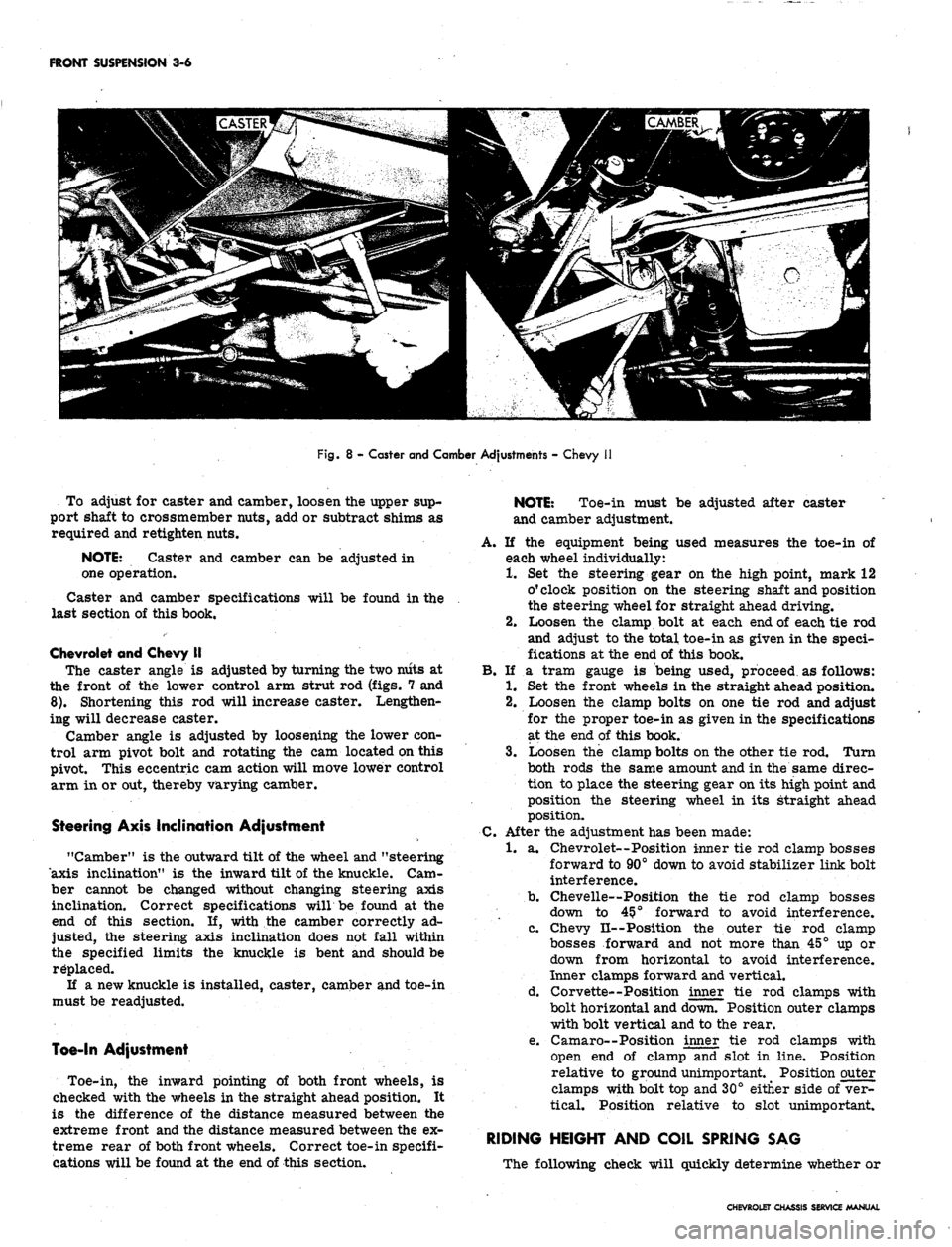
FRONT SUSPENSION 3-6
Fig.
8 - Caster and Camber Adjustments - Chevy
To adjust for caster and camber, loosen the upper sup-
port shaft to crossmember nuts, add or subtract shims as
required and retighten nuts.
NOTE:
Caster and camber can be adjusted in
one operation.
Caster and camber specifications will be found in the
last section of this book.
Chevrolet and Chevy II
The caster angle is adjusted by turning the two niits at
the front of the lower control arm strut rod (figs. 7 and
8).
Shortening this rod will increase caster. Lengthen-
ing will decrease caster.
Camber angle is adjusted by loosening the lower con-
trol arm pivot bolt and rotating the cam located on this
pivot. This eccentric cam action will move lower control
arm in or out, thereby varying camber.
Steering Axis Inclination Adjustment
"Camber" is the outward tilt of the wheel and "steering
axis inclination" is the inward tilt of the knuckle. Cam-
ber cannot be changed without changing steering axis
inclination. Correct specifications willbe found at the
end of this section. If, with the camber correctly ad-
justed, the steering axis inclination does not fall within
the specified limits the knuckle is bent and should be
replaced.
If a new knuckle is installed, caster, camber and toe-in
must be readjusted.
Toe-In Adjustment
Toe-in, the inward pointing of both front wheels, is
checked with the wheels in the straight ahead position. It
is the difference of the distance measured between the
extreme front and the distance measured between the ex-
treme rear of both front wheels. Correct toe-in specifi-
cations will be found at the end of this section.
NOTE:
Toe-in must be adjusted after caster
and camber adjustment.
A. If the equipment being used measures the toe-in of
each wheel individually:
1.
Set the steering gear on the high point, mark 12
o'clock position on the steering shaft and position
the steering wheel for straight ahead driving.
2.
Loosen the clamp bolt at each end of each tie rod
and adjust to the total toe-in as given in the speci-
fications at the end of this book.
B.
If a tram gauge is being used, proceed as follows:
1.
Set the front wheels in the straight ahead position.
2.
Loosen the clamp bolts on one tie rod and adjust
for the proper toe-in as given in the specifications
at the end of this book.
3.
Loosen the clamp bolts on the other tie rod. Turn
both rods the same amount and in the same direc-
tion to place the steering gear on its high point and
position the steering wheel in its straight ahead
position.
C.
After the adjustment has been made:
1.
a. Chevrolet—Position inner tie rod clamp bosses
forward to 90° down to avoid stabilizer link bolt
interference.
b.
Chevelle—Position the tie rod clamp bosses
down to 45?° forward to avoid interference.
c. Chevy II--Position the outer tie rod clamp
bosses forward and not more than 45° up or
down from horizontal to avoid interference.
Inner clamps forward and vertical.
d. Corvette--Position inner tie rod clamps with
bolt horizontal and down. Position outer clamps
with bolt vertical and to the rear.
e. Camaro—Position inner tie rod clamps with
open end of clamp and slot in line. Position
relative to ground unimportant. Position outer
clamps with bolt top and 30° either side of ver-
tical. Position relative to slot unimportant.
RIDING HEIGHT AND COIL SPRING SAG
The following check will quickly determine whether or
CHEVROLET CHASSIS SERVICE MANUAL